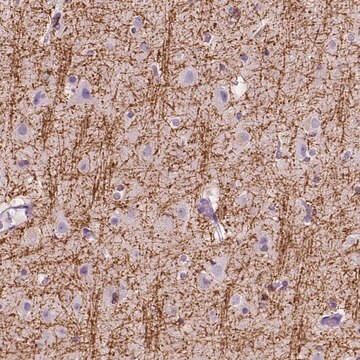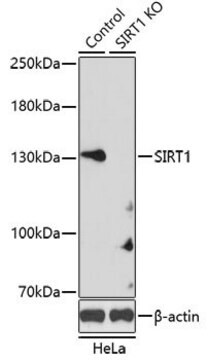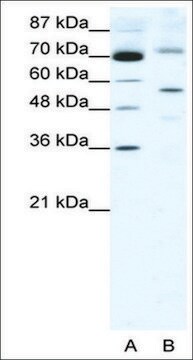일반 설명
Rabbit polyclonal anti-Sirt2 antibody recognizes mouse, rat (37/43 kDa), and human (43 kDa) Sirt2. Detection of the Sirt2 bands by immunoblotting is specifically inhibited with the immunizing peptide.
Sirt2 is an NAD+-dependent tubulin deacetylase. Two Sirt2 isoforms exist as the result of alternative splicing. Sirt2 is overexpressed during mitosis and is multiply phosphorylated at the G2/M transition of the cell cycle, indicating that it plays a role in the control of mitotic exit in the cell cycle. Although Sirt2 resides predominantly in the cytoplasm, it becomes enriched in the nucleus during the cell cycle where it is associated with mitotic structures. Sirt2 was found to be an oligodendroglial protein that affects cell differentiation through deacetylating α-tubulin.
Sirtuin 2 (SIRT2) is a cytoplasmic protein, which is part of the sirtuin family of proteins. SIRT2 colocalizes with microtubules. This gene is located on human chromosome 19q13.2.
면역원
synthetic peptide corresponding to amino acids 341-352 of mouse Sirt2, conjugated to KLH. The corresponding sequence is identical in rat and differs by one amino acid in human Sirt2.
애플리케이션
Anti-Sirt2 antibody has been used in western blotting and immunofluorescence.
Rabbit polyclonal anti-Sirt2 antibody may be used in several applications including immunoblotting, immunoprecipitation, and immunofluorescence.
생화학적/생리학적 작용
Sirtuin 2 (SIRT2) maintains the integrity of the genome. Inhibition of SIRT2 can lead to neuroprotection in cellular and invertebrate models of Huntington′s disease. SIRT2 can deacetylate lys40 of α-tubulin both in vitro and in vivo. Knockdown of SIRT2 by small interfering RNA (siRNA) leads to tubulin hyperacetylation.
물리적 형태
Solution in 0.01 M phosphate buffered saline, pH 7.4, containing 15 mM sodium azide.
면책조항
Unless otherwise stated in our catalog or other company documentation accompanying the product(s), our products are intended for research use only and are not to be used for any other purpose, which includes but is not limited to, unauthorized commercial uses, in vitro diagnostic uses, ex vivo or in vivo therapeutic uses or any type of consumption or application to humans or animals.









